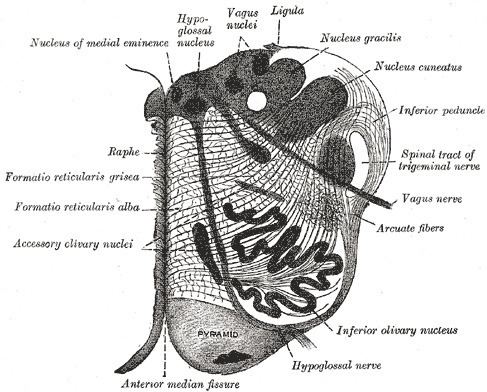Dorlands
/Elsevier g_12/12402978 | ||
 | ||
The dorsal respiratory group (DRG) is located in the dorsomedial region of the medulla, and is composed of cells in the solitary tract nucleus. The DRG is one of two known respiratory neuron localizations, with the other being the ventral respiratory group. The DRG is found in many types of fish and mammals.
Respiratory effects
The DRG is involved in the generation of respiratory rhythm, and is primarily responsible for the generation of inspiration. It is stimulated via the apneustic centre in the lower pons and is also a part of the solitary tract, which is responsible for appropriating responses to sensory information from chemoreceptors and mechanoreceptors in humans. It is inhibited by the Pneumotaxic centre.
Inspiration begins when cells of the solitary tract nucleus (along with cells of the ventral respiratory group) begin a steady increase in firing, leading to contraction of the respiratory muscles. When neurons in the DRG fire, impulses travel down the phrenic and intercostal nerves to stimulate the diaphragm and external intercostal muscles. The thoracic cavity expands and air rushes into the lungs due to the negative pressure, producing inspiration. When the cells stop firing, the inspiratory muscles relax, inspiration ceases, and exhalation begins.
The rhythm of the DRG produces a respiratory rate of 12-16 breaths per minute in humans. Inspiration usually lasts approximately 2 seconds, and expiration lasts about 3 seconds. The normal inspiration rate and rhythm is called eupnea, and difficult respiration is termed dyspnea.
